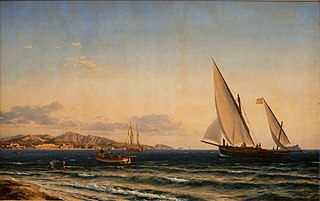
The Green Stripe is an oil painting from 1905 by French artist Henri Matisse of his wife, Amélie Noellie Matisse-Parayre. The title stems from the vertical green stripe down the middle of Madame Matisse's face, an artistic decision consistent with the techniques and values of Fauvism. The painting features a bust-length view of Madame Matisse in blocks of bold and vibrant colors. It is associated with the Fauvist Movement due to this unnatural and experimental use of color. The portrait has received both praise and criticism due to this technique as well as the artistic representation of the model. The Green Stripe is currently displayed in the Staten Museum for Kunst in Copenhagen, Denmark.

Laurits Andersen Ring was one of the foremost Danish painters of the turn of the 20th century, who pioneered both symbolism and social realism in Denmark. Considered one of the masterpieces of Danish culture, his painting Summer Day by Roskilde Fjord was included in the 2006 Danish Culture Canon.

The National Gallery of Denmark is the Danish national gallery, located in the centre of Copenhagen.

Cornelis Norbertus Gijsbrechts or Gysbrechts was a Flemish painter who was active in the Spanish Netherlands, Germany, Denmark and Sweden in the second half of the seventeenth century. He was a court painter to the Danish royal family. He specialised in trompe-l'œil still lifes, an artistic genre which uses visual tricks to give viewers the illusion that they are not looking at a painting but rather at real three-dimensional objects. He also created many vanitas still lifes.

Self-Portrait in a Striped T-shirt (1906) is an oil on canvas painting by Henri Matisse from his Fauvism period, in the collection of Statens Museum for Kunst, Copenhagen, Denmark.
Danish art is the visual arts produced in Denmark or by Danish artists. It goes back thousands of years with significant artifacts from the 2nd millennium BC, such as the Trundholm sun chariot. For many early periods, it is usually considered as part of the wider Nordic art of Scandinavia. Art from what is today Denmark forms part of the art of the Nordic Bronze Age, and then Norse and Viking art. Danish medieval painting is almost entirely known from church frescos such as those from the 16th-century artist known as the Elmelunde Master.

Bjørn Nørgaard is a Danish artist who has been active in a variety of fields. He has significantly influenced the art scene in Denmark both through his "happenings" and his sculptures in Danish cities. Although he has specialized in sculpture since 1970, his greatest achievement is perhaps his work in designing Queen Margrethe II's tapestries. Nørgaard was a professor at the Royal Danish Academy of Fine Arts from 1985 to 1994. His main workshop is in the village of Bissinge on the island of Møn.

Jacques and Berthe Lipchitz is a 1916 oil on canvas painting by Amedeo Modigliani. It depicts Modigliani's friend, the sculptor Jacques Lipchitz, standing alongside his seated wife Berthe.

Frederik Theodor Kloss was a German-Danish painter who specialized in marine painting.

Carl Frederik Emanuel Larsen usually known as Emanuel Larsen was a Danish painter who specialized in marine painting.

Hans Jørgen Hammer was a genre, landscape, and portrait painter and printmaker of the Golden Age of Danish painting. In addition, he served for eleven years as a military officer.

Anders Christian Lunde was a Danish landscape painter, a minor participant in the Golden Age of Danish painting. He painted his native Denmark including the north of Zealand and the island of Bornholm while also showing an interest in Mediterranean landscapes.

Janus Andreas Bartholin la Cour was a Danish painter who is remembered for his landscapes painted in the classical style of the Eckersberg school.
Ib Geertsen was a Danish painter and sculptor. He began as a Naturalist but later turned to Concrete art.
Søren Hansen is a Danish painter.
Lene Adler Petersen is a Danish artist. Her artistic practice is characterized through a continuous collecting, sorting and mixing process of media and techniques and includes happenings and performance art as well as painting, ceramics, drawings, printmaking and installations, film and photography.

The Reverse of a Framed Painting is a still life trompe-l'œil painting by Flemish painter Cornelius Norbertus Gysbrechts, made in 1670, when the artist was working as the official painter of the Danish royal court. The painting is commonly considered a masterpiece of trompe-l'œil painting for its deceptively sculptural representation of the back of a framed painting in a canvas.

An Egyptian Pot Seller at Gizeh is one of several paintings of Oriental women by Polish-Danish painter Elisabeth Jerichau-Baumann. It is considered one of her best works.

Johanne (Hanne) Hellesen (1801–1844) was a Danish painter who was trained privately under Johan Laurentz Jensen as women had not yet been admitted to the Royal Danish Academy. She is recognized as one of the most successful female flower painters of her times. Some of her works were purchased by the Danish Royal Collection of Paintings, two for Kronborg and two for Fredensborg Palace. Others are in the collection of Statens Museum for Kunst.

The Waagepetersen Family is an 1830 oil on canvas group portrait painting by Wilhelm Bendz, depicting the wealthy wine merchant Christian Waagepetersen, his wife Albertine Waagepetersen and two of their children in an everyday scene from their home in the Waagepetersen House on Store Strandstræde in Copenhagen. It is now in the collection of the National Gallery of Denmark.
















